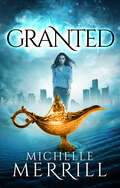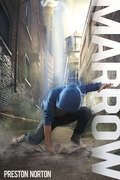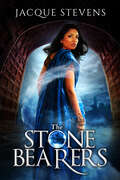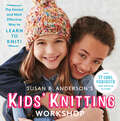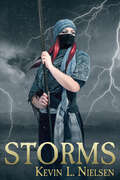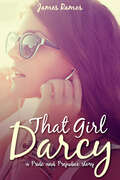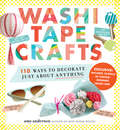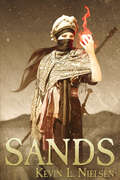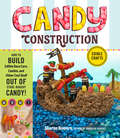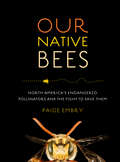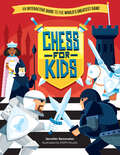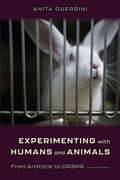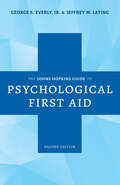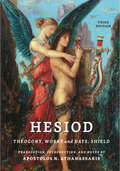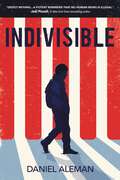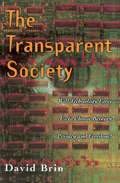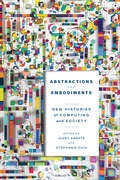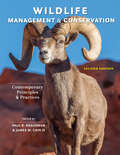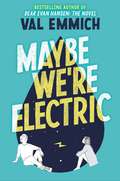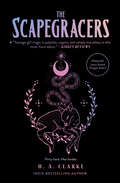- Table View
- List View
Granted
by Michelle MerrillMichelle Merrill&’s Granted imagines a world where genies like Brielle live secretly among humans. Merrill packs adventure, mystery, romance, and friendship into this coming-of-age young adult fantasy tale.
Marrow
by Preston NortonPreston Norton&’s bestselling and award-winning Marrow grabs readers and doesn&’t let go until they enroll in the Fantom Institute for Superheroes-in-Training themselves.
The Stone Bearers
by Jacque StevensIn a fantastic world of magic and mythical creatures, fifteen-year-old Ashira desperately seeks to add some excitement and romance to her dull destiny. Fans of fairy tales and Greek mythology will love Jacque Stevens&’s The Stone Bearers.
Susan B. Anderson's Kids' Knitting Workshop: The Easiest and Most Effective Way to Learn to Knit!
by Susan B. AndersonBeloved knitting instructor Susan B. Anderson presents her first book targeted at a young audience. This accessible introduction to knitting in the round includes easy-to-follow illustrated tutorials on techniques from casting on and binding off to joining colors to make stripes, and 17 progressively challenging knitting projects—beginning with simple infinity scarves and hats and building to supersweet toys and decor. Step-by-step text and photographs that kids can read and follow on their own mean they will be knitting independently in no time! Also included is a chapter on stocking your toolbox and sourcing yarn; plus advice on starting a knitting group, connecting with local knitting communities, charity knitting, and more.
Storms
by Kevin L. NielsenThis sequel to the bestselling Sands takes readers outside the desert that has Lhaurel's whole world and into a land with far more powerful and dangerous people than anything they could have imagined.
That Girl, Darcy
by James RamosJames Ramos adds a quirky new spin to a beloved classic in his modern, gender-swapped retelling of Pride and Prejudice. Fans will feel they are meeting their favorite characters for the first time as they encounter new laughs, endless high school drama, and a timeless romance with a twist.
Washi Tape Crafts: 110 Ways to Decorate Just About Anything
by Amy AndersonIt&’s the definitive washi tape craft book for adults. Washi tape—the Japanese decorative paper tape that&’s easy to tear, peel, stick and re-stick—is transformative, fun, and remarkably easy to use. It&’s also never been hotter. Packed full of amazing projects and ideas, it&’s the book and tape kit that shows all the ways to be creative with washi tape. The book includes techniques: precision tearing, wrapping, and weaving. How to make bows, rosettes, and other shapes. How to seal and weatherproof designs to make them permanent. And 110 projects, with color photographs and step-by-step instructions, from custom photo frames to one-of-a-kind gifts. The possibilities are endless.
Sands
by Kevin L. NielsenThis fantasy novel takes readers into a world of deserts and elemental magic and cultures that rarely get explored in fantasy novels. Readers will love the strong female protagonist as she fights society's rules, her own struggling magic, and the elements of nature to save people.
Candy Construction: How to Build Race Cars, Castles, and Other Cool Stuff out of Store-Bought Candy
by Sharon BowersBuild a candy fantasy! Use ordinary store-bought candy and cookies as the raw material for a brand-new kind of crafting, where castles are made with wafer-cookie walls and race cars have Oreos for wheels. Sharon Bowers provides step-by-step instructions for dozens of whimsical and fun projects that will have you seeing candy in a whole new way. From licorice pirates and centipedes made from Life Savers to marshmallow aliens and candy bento boxes, the sweet possibilities are endless.
Our Native Bees: North America's Endangered Pollinators and the Fight to Save Them
by Paige EmbryOur Native Bees is the result of Paige Embry&’s yearlong quest to learn more about the forgotten, yet fundamental, native bees of North America.
Chess for Kids: An Interactive Guide to the World's Greatest Game
by Jennifer KemmeterThis engaging workbook introduces kids to the wonderful world of chess—from an explanation of every piece on the board to the fundamentals of the game and strategies to capture pieces and win—all told through fun visuals, mock games, and exciting exercises. Chess for Kids includes:A comprehensive introduction to the king, queen, knights, bishops, rooks, and pawns and how each piece moves, attacks, and defends.Detailed explanations of the basic rules of chess, tactics, strategies, mating patterns, and piece strategies.Write-in, workbook activities to help kids &‘learn by doing,&’ unlike other chess books which are text heavy and not interactive. The best offensive and defensive strategies including how to find weak spots in your opponent's defense and how to close games when most of the board&’s pieces are gone.Learn the pieces, study the strategies, and checkmate all your opponents in this complete guide to mastering the game of chess!
Experimenting with Humans and Animals: From Aristotle to CRISPR (Johns Hopkins Introductory Studies in the History of Science)
by Anita GuerriniExamining the ideas and attitudes that encourage scientists to experiment on living creatures, what their justifications are, and how these have changed over time.Experimentation on animals—particularly humans—is often assumed to be a uniquely modern phenomenon. But the ideas and attitudes that encourage biological and medical scientists to experiment on living creatures date from the earliest expressions of Western thought. In Experimenting with Humans and Animals, Anita Guerrini looks at the history of these practices and examines the philosophical and ethical arguments that justified them.Guerrini discusses key historical episodes in the use of living beings in science and medicine, including the discovery of blood circulation, the development of smallpox and polio vaccines, and recent research in genetics, ecology, and animal behavior. She also explores the rise of the antivivisection movement in Victorian England, the modern animal rights movement, and current debates over gene therapy and genetically engineered animals. We learn how perceptions and understandings of human and animal pain have changed; how ideas of class, race, and gender have defined the human research subject; and that the ethical values of science seldom stray far from the society in which scientists live and work.Thoroughly rewritten and updated, with new material in every chapter, the book emphasizes a broader understanding of experimentation and adds material on gene therapy, self-experimentation, and prisoners and slaves as experimental subjects. A new chapter brings the story up to the present while reflecting on the current regulatory scene, new developments in science, and emerging genomics. Experimenting with Humans and Animals offers readers a context within which to understand more fully the responsibility we all bear for the suffering inflicted on other living beings in the name of scientific knowledge.
The Johns Hopkins Guide to Psychological First Aid
by George S. Everly Jr. Jeffrey M. LatingLearn the essential skills of psychological first aid from the experts—the creators of the Johns Hopkins RAPID PFA method.Psychological first aid, or PFA, is designed to mitigate the effects of acute stress and trauma and assist those in crisis to cope effectively. PFA can be applied in emergencies, including disasters, terrorist attacks, and the COVID-19 pandemic. In the second edition of this essential guide, George S. Everly, Jr., and Jeffrey M. Lating draw on their experiences in Kuwait after the Gulf War, in New York City after the September 11 attacks, and during the COVID-19 pandemic to describe the principles and practices of PFA in an easy-to-follow, prescriptive, and practical manner. Informed by current events, the second edition includes updated chapters as well as three completely new chapters on • cultural awareness• PFA considerations with children• the use of PFA to facilitate community mental health and resilienceAimed at mental health practitioners, first responders, and global health disaster teams such as Médecins Sans Frontières and the World Health Organization, but also beneficial to those with little or no previous mental health training, The Johns Hopkins Guide to Psychological First Aid thoroughly explains RAPID PFA. RAPID, a unique evidence-informed and evidence-based PFA method, follows a set of easily understood principles. In each chapter, Everly and Lating—who have traveled nationally and internationally to teach the RAPID PFA model in numerous public health, fire, police, military, business, and faith-based settings—provide a step-by-step approach and include a key point summary. A unifying case exemplifies each phase of the RAPID PFA model in an ongoing dialogue that presents ideal PFA responses, examples of common mistakes, and various outcomes.
Experimenting with Humans and Animals: From Aristotle to CRISPR (Johns Hopkins Introductory Studies in the History of Science)
by Anita GuerriniExamining the ideas and attitudes that encourage scientists to experiment on living creatures, what their justifications are, and how these have changed over time.Experimentation on animals—particularly humans—is often assumed to be a uniquely modern phenomenon. But the ideas and attitudes that encourage biological and medical scientists to experiment on living creatures date from the earliest expressions of Western thought. In Experimenting with Humans and Animals, Anita Guerrini looks at the history of these practices and examines the philosophical and ethical arguments that justified them.Guerrini discusses key historical episodes in the use of living beings in science and medicine, including the discovery of blood circulation, the development of smallpox and polio vaccines, and recent research in genetics, ecology, and animal behavior. She also explores the rise of the antivivisection movement in Victorian England, the modern animal rights movement, and current debates over gene therapy and genetically engineered animals. We learn how perceptions and understandings of human and animal pain have changed; how ideas of class, race, and gender have defined the human research subject; and that the ethical values of science seldom stray far from the society in which scientists live and work.Thoroughly rewritten and updated, with new material in every chapter, the book emphasizes a broader understanding of experimentation and adds material on gene therapy, self-experimentation, and prisoners and slaves as experimental subjects. A new chapter brings the story up to the present while reflecting on the current regulatory scene, new developments in science, and emerging genomics. Experimenting with Humans and Animals offers readers a context within which to understand more fully the responsibility we all bear for the suffering inflicted on other living beings in the name of scientific knowledge.
The Johns Hopkins Guide to Psychological First Aid
by George S. Everly Jr. Jeffrey M. LatingLearn the essential skills of psychological first aid from the experts—the creators of the Johns Hopkins RAPID PFA method.Psychological first aid, or PFA, is designed to mitigate the effects of acute stress and trauma and assist those in crisis to cope effectively. PFA can be applied in emergencies, including disasters, terrorist attacks, and the COVID-19 pandemic. In the second edition of this essential guide, George S. Everly, Jr., and Jeffrey M. Lating draw on their experiences in Kuwait after the Gulf War, in New York City after the September 11 attacks, and during the COVID-19 pandemic to describe the principles and practices of PFA in an easy-to-follow, prescriptive, and practical manner. Informed by current events, the second edition includes updated chapters as well as three completely new chapters on • cultural awareness• PFA considerations with children• the use of PFA to facilitate community mental health and resilienceAimed at mental health practitioners, first responders, and global health disaster teams such as Médecins Sans Frontières and the World Health Organization, but also beneficial to those with little or no previous mental health training, The Johns Hopkins Guide to Psychological First Aid thoroughly explains RAPID PFA. RAPID, a unique evidence-informed and evidence-based PFA method, follows a set of easily understood principles. In each chapter, Everly and Lating—who have traveled nationally and internationally to teach the RAPID PFA model in numerous public health, fire, police, military, business, and faith-based settings—provide a step-by-step approach and include a key point summary. A unifying case exemplifies each phase of the RAPID PFA model in an ongoing dialogue that presents ideal PFA responses, examples of common mistakes, and various outcomes.
Hesiod: Theogony, Works and Days, Shield
by Apostolos N. AthanassakisThis best-selling translation of Hesiod's the Theogony, the Works and Days, and the Shield has been updated into the most indispensable edition yet for students of Greek mythology and literature.Next to the works of Homer, Hesiod's poems are foundational texts for students of the classics. His two major surviving works, the Theogony and the Works and Days, address the divine and the mundane, respectively. The Theogony traces the origins of the Greek gods and recounts the events surrounding the crowning of Zeus as their king, while the Works and Days is a manual of moral instruction in verse addressed to farmers and peasants. Though modern scholars dispute the authorship of the Shield, ancient texts treat this final poem about the shield of Herakles as unquestionably Hesiodic.Introducing his celebrated translations of Hesiod, Apostolos N. Athanassakis positions the philosopher-poet as heir to a long tradition of Hellenic poetry. Hesiod's poems demonstrate the author's passionate interest in the governance of human society through justice and a tangible work ethic. As a physicist and a materialist, Hesiod avoided such subjects as honor and the afterlife. His works contain the oldest fundamentals on law and Greek economy, making Hesiod the first great thinker of Western civilization. Athanassakis's contextual notes offer both comparison to Biblical and Norse mythologies as well as anthropological connections to modern Greece.The third edition of this classic undergraduate text includes a thoroughly updated bibliography reflecting the last two decades of scholarship. The introductions and notes have been enriched, clarifying contextual history and the meaning of Hesiod's own language and themes, and notes have been newly added to the Shield. Athanassakis has lightly improved his translation throughout the text, expertly balancing the natural flow of the verse while adhering closely to the literal Greek.
Hesiod: Theogony, Works and Days, Shield
by Apostolos N. AthanassakisThis best-selling translation of Hesiod's the Theogony, the Works and Days, and the Shield has been updated into the most indispensable edition yet for students of Greek mythology and literature.Next to the works of Homer, Hesiod's poems are foundational texts for students of the classics. His two major surviving works, the Theogony and the Works and Days, address the divine and the mundane, respectively. The Theogony traces the origins of the Greek gods and recounts the events surrounding the crowning of Zeus as their king, while the Works and Days is a manual of moral instruction in verse addressed to farmers and peasants. Though modern scholars dispute the authorship of the Shield, ancient texts treat this final poem about the shield of Herakles as unquestionably Hesiodic.Introducing his celebrated translations of Hesiod, Apostolos N. Athanassakis positions the philosopher-poet as heir to a long tradition of Hellenic poetry. Hesiod's poems demonstrate the author's passionate interest in the governance of human society through justice and a tangible work ethic. As a physicist and a materialist, Hesiod avoided such subjects as honor and the afterlife. His works contain the oldest fundamentals on law and Greek economy, making Hesiod the first great thinker of Western civilization. Athanassakis's contextual notes offer both comparison to Biblical and Norse mythologies as well as anthropological connections to modern Greece.The third edition of this classic undergraduate text includes a thoroughly updated bibliography reflecting the last two decades of scholarship. The introductions and notes have been enriched, clarifying contextual history and the meaning of Hesiod's own language and themes, and notes have been newly added to the Shield. Athanassakis has lightly improved his translation throughout the text, expertly balancing the natural flow of the verse while adhering closely to the literal Greek.
Indivisible
by Daniel AlemanThis timely, moving debut novel follows a teen's efforts to keep his family together as his parents face deportation.Mateo Garcia and his younger sister, Sophie, have been taught to fear one word for as long as they can remember: deportation. Over the past few years, however, the fear that their undocumented immigrant parents could be sent back to Mexico has started to fade. Ma and Pa have been in the United States for so long, they have American-born children, and they're hard workers and good neighbors. When Mateo returns from school one day to find that his parents have been taken by ICE, he realizes that his family's worst nightmare has become a reality. With his parents' fate and his own future hanging in the balance, Mateo must figure out who he is and what he is capable of, even as he's forced to question what it means to be an American.Daniel Aleman's Indivisible is a remarkable story—both powerful in its explorations of immigration in America and deeply intimate in its portrait of a teen boy driven by his fierce, protective love for his parents and his sister.
The Transparent Society: Will Technology Force Us To Choose Between Privacy And Freedom?
by David BrinIn New York and Baltimore, police cameras scan public areas twenty-four hours a day. Huge commercial databases track you finances and sell that information to anyone willing to pay. Host sites on the World Wide Web record every page you view, and "smart” toll roads know where you drive. Every day, new technology nibbles at our privacy.Does that make you nervous? David Brin is worried, but not just about privacy. He fears that society will overreact to these technologies by restricting the flow of information, frantically enforcing a reign of secrecy. Such measures, he warns, won't really preserve our privacy. Governments, the wealthy, criminals, and the techno-elite will still find ways to watch us. But we'll have fewer ways to watch them. We'll lose the key to a free society: accountability.The Transparent Society is a call for "reciprocal transparency.” If police cameras watch us, shouldn't we be able to watch police stations? If credit bureaus sell our data, shouldn't we know who buys it? Rather than cling to an illusion of anonymity-a historical anomaly, given our origins in close-knit villages-we should focus on guarding the most important forms of privacy and preserving mutual accountability. The biggest threat to our freedom, Brin warns, is that surveillance technology will be used by too few people, now by too many.A society of glass houses may seem too fragile. Fearing technology-aided crime, governments seek to restrict online anonymity; fearing technology-aided tyranny, citizens call for encrypting all data. Brins shows how, contrary to both approaches, windows offer us much better protection than walls; after all, the strongest deterrent against snooping has always been the fear of being spotted. Furthermore, Brin argues, Western culture now encourages eccentricity-we're programmed to rebel! That gives our society a natural protection against error and wrong-doing, like a body's immune system. But "social T-cells” need openness to spot trouble and get the word out. The Transparent Society is full of such provocative and far-reaching analysis.The inescapable rush of technology is forcing us to make new choices about how we want to live. This daring book reminds us that an open society is more robust and flexible than one where secrecy reigns. In an era of gnat-sized cameras, universal databases, and clothes-penetrating radar, it will be more vital than ever for us to be able to watch the watchers. With reciprocal transparency we can detect dangers early and expose wrong-doers. We can gauge the credibility of pundits and politicians. We can share technological advances and news. But all of these benefits depend on the free, two-way flow of information.
Abstractions and Embodiments: New Histories of Computing and Society (Studies in Computing and Culture)
by Janet Abbate and Stephanie DickCutting-edge historians explore ideas, communities, and technologies around modern computing to explore how computers mediate social relations.Computers have been framed both as a mirror for the human mind and as an irreducible other that humanness is defined against, depending on different historical definitions of "humanness." They can serve both liberation and control because some people's freedom has historically been predicated on controlling others. Historians of computing return again and again to these contradictions, as they often reveal deeper structures.Using twin frameworks of abstraction and embodiment, a reformulation of the old mind-body dichotomy, this anthology examines how social relations are enacted in and through computing. The authors examining "Abstraction" revisit central concepts in computing, including "algorithm," "program," "clone," and "risk." In doing so, they demonstrate how the meanings of these terms reflect power relations and social identities. The section on "Embodiments" focuses on sensory aspects of using computers as well as the ways in which gender, race, and other identities have shaped the opportunities and embodied experiences of computer workers and users. Offering a rich and diverse set of studies in new areas, the book explores such disparate themes as disability, the influence of the punk movement, working mothers as technical innovators, and gaming behind the Iron Curtain. Abstractions and Embodiments reimagines computing history by questioning canonical interpretations, foregrounding new actors and contexts, and highlighting neglected aspects of computing as an embodied experience. It makes the profound case that both technology and the body are culturally shaped and that there can be no clear distinction between social, intellectual, and technical aspects of computing. Contributors: Janet Abbate, Marc Aidinoff, Troy Kaighin Astarte, Ekaterina Babinsteva, André Brock, Maarten Bullynck, Jiahui Chan, Gerardo Con Diaz, Liesbeth De Mol, Stephanie Dick, Kelcey Gibbons, Elyse Graham, Michael J. Halvorson, Mar Hicks, Scott Kushner, Xiaochang Li, Zachary Loeb, Lisa Nakamura, Tiffany Nichols, Laine Nooney, Elizabeth Petrick, Cierra Robson, Hallam Stevens, Jaroslav Švelch
Abstractions and Embodiments: New Histories of Computing and Society (Studies in Computing and Culture)
by Janet Abbate Stephanie DickCutting-edge historians explore ideas, communities, and technologies around modern computing to explore how computers mediate social relations.Computers have been framed both as a mirror for the human mind and as an irreducible other that humanness is defined against, depending on different historical definitions of "humanness." They can serve both liberation and control because some people's freedom has historically been predicated on controlling others. Historians of computing return again and again to these contradictions, as they often reveal deeper structures.Using twin frameworks of abstraction and embodiment, a reformulation of the old mind-body dichotomy, this anthology examines how social relations are enacted in and through computing. The authors examining "Abstraction" revisit central concepts in computing, including "algorithm," "program," "clone," and "risk." In doing so, they demonstrate how the meanings of these terms reflect power relations and social identities. The section on "Embodiments" focuses on sensory aspects of using computers as well as the ways in which gender, race, and other identities have shaped the opportunities and embodied experiences of computer workers and users. Offering a rich and diverse set of studies in new areas, the book explores such disparate themes as disability, the influence of the punk movement, working mothers as technical innovators, and gaming behind the Iron Curtain. Abstractions and Embodiments reimagines computing history by questioning canonical interpretations, foregrounding new actors and contexts, and highlighting neglected aspects of computing as an embodied experience. It makes the profound case that both technology and the body are culturally shaped and that there can be no clear distinction between social, intellectual, and technical aspects of computing. Contributors: Janet Abbate, Marc Aidinoff, Troy Kaighin Astarte, Ekaterina Babinsteva, André Brock, Maarten Bullynck, Jiahui Chan, Gerardo Con Diaz, Liesbeth De Mol, Stephanie Dick, Kelcey Gibbons, Elyse Graham, Michael J. Halvorson, Mar Hicks, Scott Kushner, Xiaochang Li, Zachary Loeb, Lisa Nakamura, Tiffany Nichols, Laine Nooney, Elizabeth Petrick, Cierra Robson, Hallam Stevens, Jaroslav Švelch
Wildlife Management and Conservation: Contemporary Principles and Practices
by Paul R. Krausman James W. CainThe definitive textbook for students of wildlife management, now updated to cover the latest techniques, tools, and topics.Wildlife Management and Conservation presents a clear overview of the management and conservation of animals, their habitats, and how people influence both. The relationship among these three components of wildlife management is explained in chapters written by leading experts and is designed to prepare students for careers in which they will be charged with maintaining healthy animal populations. To be successful wildlife professionals, they will need to find ways to restore depleted populations, reduce overabundant, introduced, or pest species, and manage relationships among various human stakeholders. This book gives them the basic knowledge necessary to accomplish these goals.This second edition, which is updated throughout, features several new and expanded topics, including communication in the wildlife profession, fire science, Indigenous models of management and conservation, plant–animal interactions, quantitative analysis of wildlife populations, and a detailed glossary. The book also covers:• Human dimensions of wildlife management• Animal behavior• Predator–prey relationships• Structured decision making• Issues of scale in wildlife management• Wildlife health• Historical context of wildlife management and conservation• Hunting and trapping• Nongame species• Nutrition ecology• Water management• Climate change• Conservation planningThe most widely used foundational text in the field, this is the perfect resource not only for students but also for early career professionals and those in related fields who need to understand the core tenets and tools of wildlife conservation and management.Contributors: C. Jane Anderson, Bart M. Ballard, Warren B. Ballard, John A. Bissonette, Clint Boal, Scott B. Boyle, Leonard A. Brennan, Robert D. Brown, James W. Cain III, Tyler A. Campbell, Michael J. Cherry, Michael R. Conover, Daniel J. Decker, Randall W. DeYoung, Jonathan B. Dinkins, W. Sue Fairbanks, Selma N. Glasscock, James B. Grand, Michael J. Haney, James R. Heffelfinger, Scott E. Henke, Fidel Hernandez, Davie G. Hewitt, C. L. Hoving, David A. Jessup, Heather E. Johnson, Winifred B. Kessler, John L. Koprowski, Paul R. Krausman, William P. Kuvlesky, Jr., Roel R. Lopez, R. W. Mannan, Scott Mills, Michael S. Mitchell, Michael L. Morrison, Anna M. Muñoz, John F. Organ, Katherine L. Parker, William F. Porter, Shawn J. Riley, Steven S. Rosenstock, Michael C. Runge, Susan P. Rupp, William F. Siemer, Robert J. Steidl, Kelley M. Stewart
Wildlife Management and Conservation: Contemporary Principles and Practices
by Paul R. Krausman And James W. Cain IIIThe definitive textbook for students of wildlife management, now updated to cover the latest techniques, tools, and topics.Wildlife Management and Conservation presents a clear overview of the management and conservation of animals, their habitats, and how people influence both. The relationship among these three components of wildlife management is explained in chapters written by leading experts and is designed to prepare students for careers in which they will be charged with maintaining healthy animal populations. To be successful wildlife professionals, they will need to find ways to restore depleted populations, reduce overabundant, introduced, or pest species, and manage relationships among various human stakeholders. This book gives them the basic knowledge necessary to accomplish these goals.This second edition, which is updated throughout, features several new and expanded topics, including communication in the wildlife profession, fire science, Indigenous models of management and conservation, plant–animal interactions, quantitative analysis of wildlife populations, and a detailed glossary. The book also covers:• Human dimensions of wildlife management• Animal behavior• Predator–prey relationships• Structured decision making• Issues of scale in wildlife management• Wildlife health• Historical context of wildlife management and conservation• Hunting and trapping• Nongame species• Nutrition ecology• Water management• Climate change• Conservation planningThe most widely used foundational text in the field, this is the perfect resource not only for students but also for early career professionals and those in related fields who need to understand the core tenets and tools of wildlife conservation and management.Contributors: C. Jane Anderson, Bart M. Ballard, Warren B. Ballard, John A. Bissonette, Clint Boal, Scott B. Boyle, Leonard A. Brennan, Robert D. Brown, James W. Cain III, Tyler A. Campbell, Michael J. Cherry, Michael R. Conover, Daniel J. Decker, Randall W. DeYoung, Jonathan B. Dinkins, W. Sue Fairbanks, Selma N. Glasscock, James B. Grand, Michael J. Haney, James R. Heffelfinger, Scott E. Henke, Fidel Hernandez, Davie G. Hewitt, C. L. Hoving, David A. Jessup, Heather E. Johnson, Winifred B. Kessler, John L. Koprowski, Paul R. Krausman, William P. Kuvlesky, Jr., Roel R. Lopez, R. W. Mannan, Scott Mills, Michael S. Mitchell, Michael L. Morrison, Anna M. Muñoz, John F. Organ, Katherine L. Parker, William F. Porter, Shawn J. Riley, Steven S. Rosenstock, Michael C. Runge, Susan P. Rupp, William F. Siemer, Robert J. Steidl, Kelley M. Stewart
Maybe We're Electric
by Val EmmichFrom Val Emmich, the bestselling author of Dear Evan Hansen: The Novel, comes a deeply affecting story of two teens who find themselves thrown together overnight during a snowstorm and discover a surprising connection—perfect for fans of Nina LaCour, David Arnold, and Robin Benway.Tegan Everly is quiet. Known around school simply as the girl with the hand, she's usually only her most outspoken self with her friend Neel, and right now they're not exactly talking. When Tegan is ambushed by her mom with a truth she can't face, she flees home in a snowstorm, finding refuge at a forgotten local attraction—the tiny Thomas Edison museum.She's not alone for long. In walks Mac Durant. Striking, magnetic, a gifted athlete, Mac Durant is the classmate adored by all. Tegan can't stand him. Even his name sounds fake. Except the Mac Durant she thinks she knows isn't the one before her now—this Mac is rattled and asking her for help.Over one unforgettable night spent consuming antique records and corner-shop provisions, Tegan and Mac cast aside their public personas and family pressures long enough to forge an unexpectedly charged bond and—in the very spot in New Jersey that inspired Edison's boldest creations—totally reinvent themselves. But could Tegan's most shameful secret destroy what they've built?Emotionally vivid and endlessly charming, Maybe We're Electric is an artfully woven meditation on how pain can connect us—we can carry it alone in darkness or share the burden and watch the world light up again.
The Scapegracers (The\scapegracers Ser. #1)
by H.A. ClarkeA YA crossover title combining the perennially popular genres of witches and high school society told in a bright, distinctive, and inclusive voice, and the debut of a talented young voice writing Erewhon's first series acquisition.
